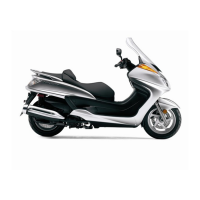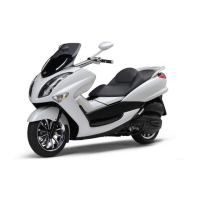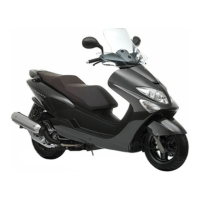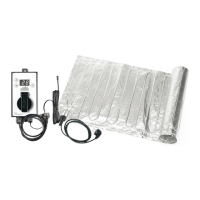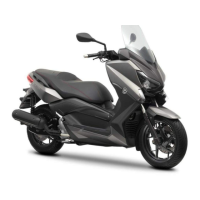Do you have a question about the Yamaha Majesty YP400Z and is the answer not in the manual?
Read and understand the manual and riding tips booklet before operating the scooter.
Explains symbols and notations used in the manual for warnings, notices, and tips.
Owner's responsibility for safe and proper operation, and requirements for operators.
Guidance on safe riding, including pre-operation checks and conspicuousness.
Details on essential protective clothing for safe riding and injury prevention.
Information on the dangers of carbon monoxide and precautions to avoid it.
Precautions and guidelines for loading accessories and cargo to maintain stability.
Information on choosing and using genuine Yamaha accessories for safety and performance.
Considerations regarding aftermarket parts and modifications for safety and performance.
Notes on selecting and using aftermarket tires and rims for optimal performance.
Further safety tips including signaling, braking, and awareness of road conditions.
Identifies components and parts visible from the left side of the scooter.
Identifies components and parts visible from the right side of the scooter.
Diagram and labeling of the scooter's controls and instrument panel.
Details on the functions of the main switch and how to lock/unlock the steering.
Explanation of the various indicator and warning lights on the instrument panel.
Description of the speedometer and its self-check function when the ignition is turned on.
Information on the tachometer, its function, and the engine speed red zone.
Overview of the multi-function display, including its various meters and indicators.
How to switch between odometer, tripmeters, and fuel reserve tripmeter modes.
Explanation of the fuel meter and the fuel level warning indicator.
Description of the coolant temperature meter and warning indicator.
How the oil change indicator works and how to reset it.
Information on the V-belt replacement indicator and its function.
Explanation of the self-diagnosis device and error code reporting.
Step-by-step instructions for setting the clock on the multi-function display.
How the ambient temperature display works and its limitations.
Details on the operation of handlebar switches on both the left and right sides.
How to operate the front brake lever for braking.
How to operate the rear brake lever for braking.
Explanation of the rear brake lock lever and how to use it.
Instructions for opening and closing the fuel tank cap.
Important safety precautions and instructions for refueling the vehicle.
Specifies the recommended type of unleaded gasoline for the scooter.
Information on using gasohol, including ethanol and methanol content.
Safety warnings related to the catalytic converter and hot exhaust system.
Information on accessing and using the rider and passenger seats.
Instructions for removing and installing the passenger seat.
How to adjust the rider seat to change the riding position.
Instructions for opening and locking front storage compartment A.
Instructions for opening front storage compartment B.
Information on using the rear storage compartment, including capacity and precautions.
Warning regarding maximum loading limits for storage compartments and the vehicle.
Guide to adjusting the spring preload on the shock absorber assemblies.
Instructions for using the sidestand and safety precautions related to its switch.
Explanation of the ignition circuit cut-off system and its functions.
Procedure for checking the fuel level, refueling, and checking for fuel line leakage.
Procedure for checking engine oil level and for oil leakage.
Procedure for checking the final transmission oil for leakage.
Procedure for checking coolant level and for cooling system leakage.
Checks for front brake operation, fluid level, pads, and system leakage.
Checks for rear brake operation, fluid level, pads, and system leakage.
Checking throttle grip operation and cable free play.
Checking wheels and tires for damage, tread depth, and air pressure.
Checking brake lever operation and lubricating pivot points.
Checking centerstand and sidestand operation and lubricating pivots.
Checking the operation of instruments, lights, signals, and switches.
Checking the sidestand switch operation and the ignition circuit cut-off system.
Step-by-step guide for starting the engine, including safety checks.
Instructions for starting off from a standstill, including centerstand removal.
Explanation of how to control speed using the throttle grip.
Guidance on braking, including safe techniques and warnings for slippery surfaces.
Instructions for breaking in the engine during the initial period for optimal performance.
Safe practices for parking the scooter, including hot exhaust system warnings.
Information about the owner's tool kit and its use for maintenance.
Checking and replacing fuel lines for cracks or damage.
Checking, cleaning, adjusting, and replacing the spark plug.
Checking and adjusting valve clearance when the engine is cold.
Checking the breather hose for cracks or damage and replacing if necessary.
Checking the engine idle speed for the fuel injection system.
Checking the control system for damage and replacing if necessary.
Checking the air cut-off valve, reed valve, and hose for damage.
Procedure for replacing air filter elements.
Procedure for cleaning the V-belt case air filter element.
Checking operation, fluid level, leakage, and replacing brake pads.
Checking operation, fluid level, leakage, and replacing brake pads.
Checking brake hoses for cracks or damage.
Checking and adjusting the rear brake lock operation.
Checking wheels for runout, damage, and replacing if necessary.
Checking tires for tread depth, damage, air pressure, and replacing.
Checking wheel bearings for smooth operation and replacing if necessary.
Checking steering bearings for looseness and repacking with grease.
Checking all chassis fittings and fasteners and correcting if necessary.
Lubricating the front brake lever pivot shaft.
Lubricating the rear brake lever pivot shaft.
Checking centerstand and sidestand operation and lubricating pivots.
Checking sidestand switch operation and replacing if necessary.
Checking front fork operation and for oil leakage.
Checking shock absorber assemblies for operation and oil leakage.
Procedure for changing engine oil, including checking oil level and leakage.
Procedure for replacing the engine oil filter element.
Checking coolant level and vehicle for leakage, and changing coolant.
Checking final transmission oil for leakage and changing the oil.
Procedure for replacing the V-belt when the indicator flashes.
Checking the operation of front and rear brake switches.
Checking throttle grip operation and free play, and lubricating.
Checking operation of lights, signals, and switches, and adjusting headlight beam.
Notes on servicing air filter elements and V-belt air filter elements.
Information on changing brake fluid and replacing brake hose components.
General instructions for removing and installing various cowlings and panels.
Specific instructions for removing and installing Cowling A.
Specific instructions for removing and installing Cowling B.
Instructions for removing and installing Cowlings C and D.
Specific instructions for removing and installing Cowling E.
Specific instructions for removing and installing Panel A.
Specific instructions for removing and installing Panel B.
How to check the spark plug's porcelain insulator and electrode condition.
Procedure for measuring spark plug gap, cleaning, and installing the spark plug.
Checking canister hoses and ensuring the breather is not blocked.
Procedure for checking engine oil level and warming up the engine.
Step-by-step guide for draining engine oil and replacing the oil filter element.
Procedure for resetting the oil change indicator after an oil change.
Procedure for checking and changing the final transmission oil.
Procedure for checking the coolant level in the reservoir.
Servicing air filter elements and checking hoses.
Instructions for cleaning dirt and water from air filter check hoses.
Procedure for cleaning the V-belt case air filter element using compressed air.
How to check and adjust the throttle cable free play.
Importance of valve clearance adjustment by a dealer for performance.
Checking tire air pressure and inspecting tires for wear and damage.
Checking cast wheels for damage, bends, and proper balancing.
Checking for free play at the brake lever ends and warning about soft feeling.
How to adjust the rear brake lock lever cable length for proper holding.
How to check brake pads for wear using indicator grooves.
Procedure for checking brake fluid level and precautions for refilling.
Information on when to change brake fluid and replace oil seals and hoses.
Importance of checking and lubricating control cables for smooth operation.
How to check and lubricate the throttle grip and cable.
Lubricating the pivoting points of the front and rear brake levers.
Checking and lubricating the centerstand and sidestand pivots.
How to check the front fork for scratches, damage, oil leakage, and smooth operation.
How to check for worn or loose steering bearings.
How to check front and rear wheel bearings for play or smooth turning.
Checking battery lead connections and general care for the VRLA battery.
Instructions for charging the VRLA battery using a special charger.
Procedure for removing, charging, and storing the battery during long periods of non-use.
Instructions for identifying and replacing blown fuses, with warnings about amperage.
Procedure for replacing the headlight bulb and adjusting the beam.
Information on the LED tail/brake light and what to do if it doesn't come on.
Step-by-step guide for replacing a front turn signal light bulb.
Step-by-step guide for replacing a rear turn signal light bulb.
Instructions for removing and replacing the license plate light bulb.
Introduction to troubleshooting common problems with fuel, compression, or ignition systems.
Charts to diagnose starting problems related to fuel, compression, ignition, and battery.
Procedure to follow if the engine overheats, including radiator cap warnings.
Advice on cleaning and caring for matte colored finished parts to avoid damage.
Importance of regular care, cleaning procedures, and protecting against rust.
Procedure for cleaning the scooter after normal riding conditions.
Specific steps for cleaning the scooter after exposure to sea salt or road salt.
Steps after cleaning, including drying, polishing, and applying protection.
Guidelines for storing the scooter in a cool, dry place to protect against dust.
Instructions for storing the scooter for several months, including fuel stabilization.
Detailed measurements of the scooter's overall length, width, height, wheelbase, etc.
Specifies the weight of the scooter with oil and fuel.
Details on engine type, displacement, bore, stroke, compression, and lubrication.
Recommended engine oil brand, type, grade, and quantity.
Recommended final transmission oil type and quantity.
Coolant reservoir and radiator capacities.
Details on frame type, caster angle, trail, front/rear tire specifications.
Recommended tire air pressure based on loading conditions.
Details on front wheel type and rim size.
Details on rear wheel type and rim size.
Type, operation, and recommended fluid for the front brake.
Type, operation, and recommended fluid for the rear brake.
Details on front suspension type, spring/shock absorber, and wheel travel.
Details on rear suspension type, spring/shock absorber, and wheel travel.
Ignition system type and charging system details.
Model, voltage, and capacity of the scooter's battery.
Bulb type and wattage for the headlight.
Type of tail/brake light (LED).
Voltage, wattage, and quantity for front turn signal and position lights.
Voltage, wattage, and quantity for rear turn signal lights.
Voltage, wattage, and quantity for the license plate light.
Voltage, wattage, and quantity for meter illumination.
Voltage, wattage, and quantity for the high beam indicator light.
Voltage, wattage, and quantity for turn signal indicator lights.
Voltage, wattage, and quantity for the engine trouble warning light.
List of all fuses, their amperage ratings, and circuit assignments.
Recording key, vehicle identification, and model label information for reference.
Instructions for recording the key identification number from the key tag.
Location of the vehicle identification number stamped on the frame.
Location and recording of information from the model label.
Location of the emission control label showing exhaust emission specifications.
Procedure for reporting safety defects to NHTSA and obtaining safety information.
Information on prohibited tampering with the noise control system.
A chart for recording completed maintenance services for warranty purposes.
Details of the limited warranty period, coverage, and exclusions for Yamaha motorcycles.
Specifies the warranty period for Yamaha motorcycles.
Lists models excluded from the standard warranty coverage.
Lists common causes that void the warranty, such as abuse or neglect.
Lists specific parts or conditions excluded from warranty coverage.
Customer obligations for maintaining warranty, including operation and reporting defects.
Procedure for transferring the warranty to a subsequent owner.
Warranty coverage for the emission control system and its limitations.
Answers to common questions regarding warranty coverage, costs, and procedures.
How to contact Yamaha for warranty service and assistance.
Procedure for notifying Yamaha of address changes for registration records.
Information on the Y.E.S. program for extended coverage and its benefits.
| Engine Type | Liquid-cooled, 4-stroke, DOHC, 4-valve |
|---|---|
| Displacement | 395cc |
| Bore x Stroke | 83.0 mm x 73.0 mm |
| Compression Ratio | 10.6:1 |
| Fuel System | Fuel Injection |
| Ignition | TCI |
| Starter System | Electric |
| Transmission | V-belt automatic |
| Front Suspension | Telescopic fork |
| Rear Suspension | Unit Swing |
| Rear Tire | 150/70-13M/C 64S |
| Overall Length | 2, 230 mm |
| Seat Height | 760 mm |
| Wheelbase | 1, 565 mm |
| Fuel Capacity | 14 liters |
| Rear Brake | Hydraulic single disc, Ø267 mm |
| Max Torque | 36.3 Nm (3.7 kg-m) @ 6, 000 rpm |
| Front Brake | Dual discs, Ø 267 mm |
| Weight | 222 kg (Wet) |
